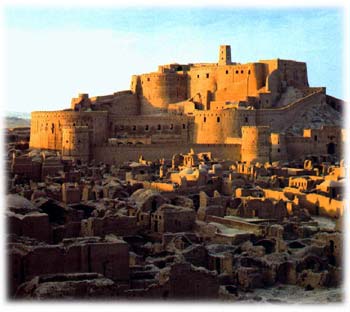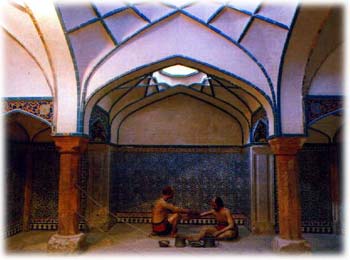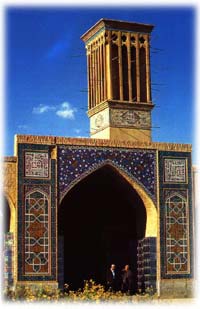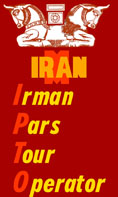|
Being
a province of great antiquity kerman contains numerous monuments
dating back both to pre-Islamic and post-Islamic periods.
It
is located in the south-eastern Iran and covers an area of 180,000
sq. kms. Kerman is bounded on the north by yazd and Khorasan, on the
east by Sistan va Baluchestan, on the south by Hormozgan, and on the
west by Fars.
The central and western areas, being mountainous,
are cold in winter and mild in summer. The western and eastern parts
containing vast areas of desert have long hot summers and short mild
winters. The Lut Desert, lying north of the province, plays a
significant role in the climate.
The two ranges of mountains
stretching from northwest to southeast from the central mountains of
Iran. The mountain-ranges of Kuhbanan, jebal-e Barez and
shahsavaran, and the mountains of Chehel Tan, bid Khan, Davaran and
jupar are of more importance.
Mt. Jupar (4100 meters) lying to
the southeast of the provincial, attracts many people. Interested in
mountain and rock climbing, wildlife rich in variety and being in
the vicinity of Mahan (a town with many attractions) have great
appeal for visitors.
The lowest elevation in Iran is Shahdad
district, located in the northeast of Kerman province.
Most of
the rivers of the province are seasonal. The largest permanent river
is the Helil Rud, originating in the Baft mountains and flowing
southeastward to Jazmurian Marsh. Qanant, an irrigation water source
is tapped and the water channelled down through a series of tunnels
to the earth's surface, has been widely used for supplying some
areas with water from the distant past.
sirjan region, located in
the eastern Kerman, takes in a seasonal salt lake bing of
considerable attraction. The Kavir-e Lut, an immense desert located
in the northeast of the province, has its own appeal.
The mineral
springs of Abareq and Dah Sheykh, near the cities of Bam and Baft
respectively, with suitable facilities for bathing, can be used all
the year round.
The province mainly consists of steppes and
semiarid plateaus covered by brown or chestnut-colored soil that
supports gtassy vegetation. Thorny shrubs from the ground cover of
the steppes. Tagh trees (belonging to the goosfoot family) and
tamarisks also grow on these areas. Wild fruit trees such as Persian
turpentine trees and almond are found in mountainous regions
enjoying mild climate.
Wildlife is rich in variety. Cheetahs,
leopards, hyenas, wild boars, wolves, jackals, foxes, rabbits,
gazelles, mouflon, ibex, and the Iranian wild ass which is
threatened by extinction, are among mamals living in the province.
Wildlife sanctuaries have been established in Kerman, notable among
them are the protected areas of Mahru'iyeh and Khabr va
Ruchun.
The vast majority of the people living in Kerman are
Muslims. Persian is the dominant language, spoken in a stylish
Kermani dialect. Tribal life is also found in Kerman; notable among
them are the protected areas of Mahru'iyeh and Khabat va
Ruchun.
The vast majority of the people living in Kerman are
Muslims. Persian is the dominant language, spoken in a stylish
Kerman; the following tribes are of more importance: Ayineh, Shams
ad-Dini and Afshar.
| Bam
Bam is a city of great antiquity,200
kms south-east of Kemran.Dates,citrus fruits and henna are the most
important crope cultivated in Bam.Dating fom 2000 years ago,it was city of
Bam.called Arg-e-Bam,are of great attraction.
|
Arg-e-Bam
It is on a hill in the vicinity
of the city,being one of the world wonders covering an area of 6
sq.kms ,it is the greatest mid-brick construction in th
world.Surronded by lofty walls and towers and a moat,it includes a
great number oh houses encircling the center.Arg-e-Bam is one of the
most important tourist attraction in Iran.
A complex called new
Arg has been recently built 8 kms east of the ancien Arg.ecreational
facilities such as awimming pools sports fields and a manage on the
one hand,and easy access to the airport of Bam nd suitable hotel
accommodation on the other,make it a point of great attraction for
tourists.
Bazar
dating back to the distance past ,
the bazar is about 3 kms long and is still a center of trade in the
city,It consist of a number of section,each one called a baza
itself.The following are notabe among them :
Bazar-e-Vakil,Bazar-e-Ekhtiary,Bazar-e- Mozafarri and
Bazar-e-Mesgari(coppersmithing).The bazar includes monuments going
back to he Safavid and Zand periods.
|
 |
 |
Handicrafts &
Souvenris
The Kerman carpets ,renowed for their
elaborate border patterns, mute colours and high quality , are
regarded as the best souvenirs of Kerman.Gelims (carpets made of
goasts's hair), Jajims (fine carpets made of wool or cotton) and
Shawls are also among notable handicrafts. Furthermore, careway
seed, dates and citrus fruit cultivated in Kerman are of the highest
quality.
Shahr
babak
The ancient city of Shahr BAbak, the foundation
of wich is attributed to Ardeshir I,a king of the Sassanian dynasty,
is 250 kms west of Kerman.It has a semi-deseric climate.Of the local
sights th fallowing are of more signifixcance: Namak (salt) Lake ,to
beauty in the seasons it is filled with water ;the edfice of Vali;
Azar Bagh fire-temple; and the village of Meymand whose stone
building enjoy impressive architecture representing the peacful
coexistance of man and
Nature.
|
|

